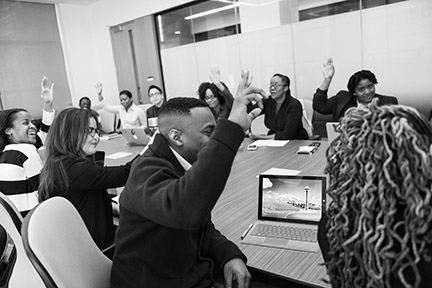A Learning Circle Blueprint for High School Equivalency Instruction in Adult Education

by Hali Massey
Learning Circle Introduction
World Education has been piloting and implementing learning circles in adult education programs since 2016. Learning circles aim to expand learning opportunities while facilitating online and peer-to-peer learning. Learners typically meet synchronously once-a-week for ninety minutes to two hours, with a cycle lasting between eight to ten weeks. The meeting time includes independent online learning and group discussion time is facilitated by a trained volunteer/instructor who does not need to be an expert in the course subject matter. While most of World Education’s learning circle work has been focused on English language instruction through their “English Now!” learning circle project, this model provides an opportunity to compensate for a variety of programmatic gaps in adult education programs including providing additional support to learners pursuing their high school equivalency (HSE).
More Information on Learning Circles: World Education English Now! Project
Example High School Equivalency Learning Circle Model, the Notre Dame Education Center
Manny Reynoso, the Program Director for Notre Dame Education Center (NDECA) in Massachusetts and long-term World Education English Now! partner, has implemented learning circles or similar models in various adult education contexts at NDEC. In a Zoom interview with the Virginia Adult Learning Resource Center (VALRC), Manny explained that NDEC started using English Now! Learning circles to meet the needs of wait-listed English language learners. However, when his program started to see increased learner gains with the learning circle model, they expanded this model to all of their English language classes and eventually to their workforce development program. Manny stated that learners receive the same information as in a traditional class, but the material is better chunked in a way that allows learners to move forward at their own pace while working in a tight-knit cohort with their fellow learners.
Because of the learner gains that NDEC saw while using the learning circle model with their English language and workforce development programs, they expanded this model to their high school equivalency program.
The benefits of using the learning circle model in an HSE program, according to Manny, are:
- The model meets students where they are.
For example, if learners have the goal of achieving their HSE to get a better job, they do not have to go through several years of HSE classes. Learners are able to attend the learning circles for the subjects that they are focusing on at that time. This means that learners can concentrate on as many subjects at once as they would like to. This type of individualized programming promotes student persistence and motivation.
- The model builds a cohort and provides more opportunity for peer-to-peer interaction.
Manny stated that for these HSE learning circles his program is using synchronous virtual sessions and leveraging breakout rooms for peer-to-peer learning and interaction. Cohorts can be organized by age group or skill level. However, this model allows programs to take advantage of multilevel classes because the cohort works on a skill until everyone feels comfortable moving on to the next one. The learning circle facilitator can use learners moving at a faster pace to facilitate peer-to-peer learning which helps to reinforce learning for those fast-paced learners, and the facilitator works to ensure that peer learning is accurate. Some learners are not interested in providing peer support, so this type of peer facilitation is not obligated. However, the facilitator needs to explain the benefits of facilitating peer-to-peer learning. This type of peer-to-peer facilitation provides acknowledgement for learners and shows teacher confidence in the learner.
- Technology is ingrained in this model.
English Now! learning circles typically use a blended learning model where learners are engaging in online learning in combination with the learning circle meetings. While Manny’s HSE programs are currently not using a distance education curriculum for their learning circles, it is possible to integrate that distance learning work into the learning circle model. At the same time, using synchronous virtual sessions for the learning circle meetings means that technology is still at the center of the program, and learners are being supported in developing their digital literacy skills. More on virtual learning circles.
Virginia Adult Education List of Approved Distance Education Curricula
- In this model, the teacher is now the facilitator and students are the participants.
While traditional learning models are teacher centered, the learning circle model is student centered. This means that if learners are going to be part of a learning circle, then participation is required. This benefit is very connected to the facilitation role of the teacher and the cohort structure of the learning circle.
- This model has increased turnaround time and success rate for HSE learners.
Manny’s HSE learning circles are formed according to HSE subjects. As previously mentioned, learners are able to customize which subjects they are studying for at one time. In addition, learning circles meet for 5–12 weeks. These two logistical factors mean that learners are able to move through their HSE preparation in a way that is more intense, faster, and individualized than traditional HSE programs. Additionally, as also mentioned, Manny has seen a significant increase in learner gains and HSE success rates using the learning circle model.
Learning Circles for HSE Logistics:
- Shorter class time increments: Manny suggests holding two learning circle sessions per week for one hour at a time. These sessions are offered per subject, and learners can choose how many subjects to engage in at a time. The shorter class time increments are more flexible for learners and reduce the time commitment that studying for an HSE can require. It is important to consider the blended learning model for this situation so that learners are engaging in learning outside of just the in-person or virtual synchronous class sessions.
- Teacher Facilitation: For this model, teachers act as facilitators. The facilitator needs to identify commonalities and pair peers based on similar learning styles, lifestyles, goals, etc.; create opportunities for peer facilitation; ensure that all information being provided by learners is accurate; and determine the cohort’s learning pace. Another option is to use volunteers to help facilitate breakout rooms. Manny suggested reaching out to local colleges and universities to find potential volunteers. More on the role of the facilitator can be found in the World Education English Now! Learning Circles Implementation Guide.
- Learner Enrollment: While not all learning circle models enroll learners into their adult education program using the National Reporting System, it is definitely possible to do so. Maryann Peterson, an adult ESOL instructor and experienced learning circle facilitator at the Thomas Jefferson Adult & Career Education program at Piedmont Virginia Community College, shared that their learning circle participants are pre-tested and post-tested, given that they accrue the required number of hours. Because learning circles do have shorter class times than traditional adult education classes and because attendance can vary, it is important to utilize a distance education curriculum so that learners can earn distance learning hours to add to their contact hours. As mentioned, integrating the use of an online learning curriculum into the learning circle model is a characteristic of the World Education English Now! learning circle model.
For more information on this learning circle model, please contact Manny Reynoso at [email protected].
Next steps for implementing learning circles in your program:
- Identify a gap in the adult education programs or services that your program provides. These could include learners on a wait list, learners requiring virtual or distance education options, multilevel classes, learners with varying attendance, learners requiring additional HSE tests or competencies, etc.
- Research the learning circle model. The resources and contacts in this article provide information on what learning circles are, their components, and how programs can implement them. If you have additional questions, please contact one of the practitioners mentioned in this article or VALRC.
- Adapt the learning circle model to fit your programmatic context and needs. While the learning circle model has some identifiable characteristics such as cohorts, synchronous meetings, peer learning, and facilitation; there are other aspects of the model that can be customized such as the use of distance learning, curriculum, type of facilitator, virtual or in-person meetings, etc.
Manny emphasized that while their ESOL program has completely adopted the learning circle model, the workforce and HSE programs have taken aspects from the model and combined them with traditional learning strategies. Their workforce program has taken the hybrid learning technology within the class and fused it with Tech Goes Home and the HSE program uses aspects of learning circles by using the classroom structure of breakout rooms with peer-to-peer practice followed by regathering as a whole group to compare notes and more. Looking at the learning circle model and finding the right cocktail that works for a given population or cohort is key.
- Develop a plan for enrolling learners using NRS. Programs have to determine how they will pre- and post-test learners, and how to ensure that learners accrue the required number of hours to post test. When using learning circles to serve wait-listed learners, programs typically pre-test in the learning circle and carry that score forward for when learners move into traditional classes.
- Train learning circle facilitators. Using the World Education English Now! Learning Circles Implementation Guide, train adult education practitioners or volunteers on the learning circle facilitation. Other training materials for learning circle facilitation include: the P2PU Facilitator Handbook and the Pro-Literacy self-paced course (coming soon).
Additional resources on learning circles in adult education:
- 8 Tips for Implementing Learning Circles in Any Program
- English Now! Webinar
- English Now! Implementation Guide
- Learning Circles Partner Spotlight: The Free Library of Philadelphia
- Propagating Promising Practices: Learning Circles
 Hali Dayberry-Massey, M.A. TESOL, is the English for Speakers of Other Languages (ESOL) Specialist at the Virginia Adult Learning Resource Center (VALRC). In this role, she coordinates teacher professional development that aligns with state and federal initiatives, as well as local interests and needs. This work includes the design and delivery of online courses, face-to-face workshops, and virtual meetings, all with a focus on the practice of teaching English to adult learners.
Hali Dayberry-Massey, M.A. TESOL, is the English for Speakers of Other Languages (ESOL) Specialist at the Virginia Adult Learning Resource Center (VALRC). In this role, she coordinates teacher professional development that aligns with state and federal initiatives, as well as local interests and needs. This work includes the design and delivery of online courses, face-to-face workshops, and virtual meetings, all with a focus on the practice of teaching English to adult learners.